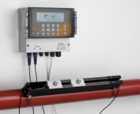Metering for Part L

Ted Farnon discusses the whats and hows of the metering requirements of Part L.
Costs, consumption and compliance with Building Regulations are high on the list of requirements for energy managers and building-services designers— and clamp-on ultrasonic metering can make a significant contribution.
However, whilst major projects such as Terminal 5 at Heathrow Airport and the ExCeL exhibition centre in London have taken advantage of the associated benefits of clamp-on ultrasonic metering, historic uptake for building services in both new build and retrofit application has been slower than expected.
One reason is probably a lack of general awareness amongst building-services designers. The benefits are evident from the use of the technology in the previously mentioned projects and others, but are not generally appreciated by the building-services industry.
However, Parts L2A and L2B of the 2010 Building Regulations (new non-dwellings and refurbishment of non-dwellings) both have a section on energy meters. So the requirement for improved metering is clear, and fixed, clamp-on meters can make a significant contribution.
L2A says: Reasonable provision for energy meters would be to install energy metering systems that enable at least 90% of the estimated annual energy consumption of each fuel to be assigned to the various end-use categories (heating, lighting etc.) Detailed guidance on how this can be achieved is given in CIBSE TM39.
It also states that the output of any renewable energy system should be separately monitored and that in buildings with a total useful floor area greater than 1000 m2, automatic meter reading and data collection facilities should be provided.
Finally, it states that the metering provisions should be designed such as to facilitate the benchmarking of energy performance as set out in CIBSE Guide TM46.
L2B says: The aim for buildings as a whole is to enable building occupiers to install energy metering systems in the building services systems provided as part of the works in accordance with the recommendations in CIBSE TM39.
And as L2A it says: Meters should be provided to enable the performance of any renewable energy system provided as part of the works to be separately monitored and in buildings with a total floor area greater than 1000 m2; the metering system should enable automatic meter reading and data collection.
The general need and demand for improved energy efficiency within our built environment is clear, and automatic metering and liquid/energy flow measurement has a key role to play.
Water-based cooling and heating systems are the core processes by which energy transfer is used to control the environment of the majority of the UK’s non-domestic stock of 2 million, and it stands to reason therefore that there is a major market potential for improved energy efficiency, automatic metering and liquid/energy flow measurement, including water sub-metering and energy sub-metering (energy flow/heat meters) that will be required from 2010 onwards.
Clamp-on, ultrasonic flow meters use either transit-time, Doppler measuring principles, or both, and can provide a cost-effective solution to the growing demand for liquid-flow measurement.
Potential applications for clamp-on flow meters or flow measurement devices within Building Services include the following.
• Hot-water sub-metering and flow measurement.
• Flow measurement for heat metering.
• Chilled water sub-metering and flow measurement.
• Flow measurement for chilled-water energy metering.
• Potable water measurement.
• Diesel and fuel oil measurement.
Micronics and other companies offer a wide range of fixed/permanent clamp-on metering solutions as an alternative to traditional in-line meters. They offer the following benefits.
• No disruption of services or problems associated with system drain down for installation and/or maintenance.
• Minimum downtime and maximum availability.
• Significant reductions in meter supply and installation costs for larger meters and retrofit applications.
• No in-line pressure drop and therefore no irrecoverable energy losses.
Meters can be applied in a stand-alone mode and provide instantaneous flow, totalised energy and volumetric values, communicate selected alarm conditions via relay outputs or be integrated with BEMS, aM&T (automatic monitoring and targeting) or billing systems via MBus and other industry standard communications.
At Terminal 5, clamp-on, ultrasonic flow meters were incorporated into the design. They provide automatic energy metering in both the terminal and the energy centre, with the benefits of high availability and simple non-disruptive maintenance.
The 2010 Building Regulations clearly state the requirement for improved metering in both new and refurbished buildings — and fixed, clamp-on metering can make a significant contribution to complying with the regulations and helping to reduce energy consumption
Ted Farnon is founder and chairman at Micronics.







